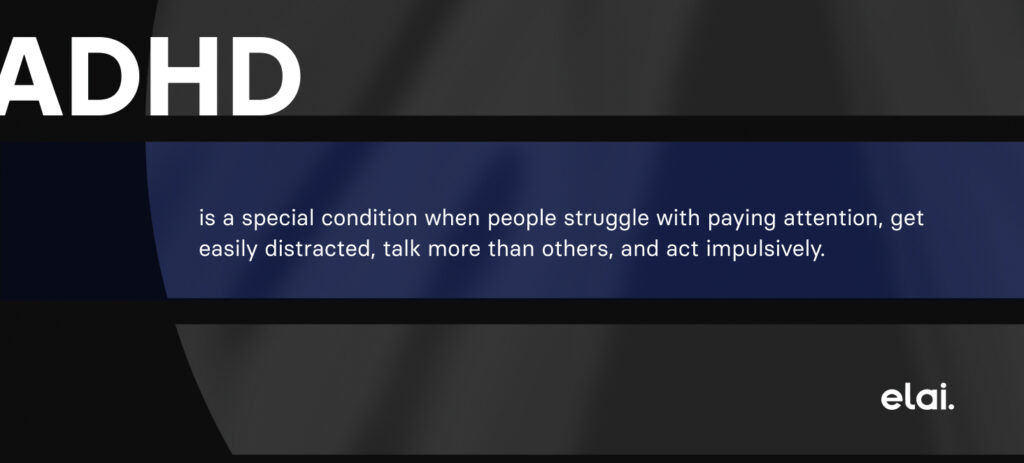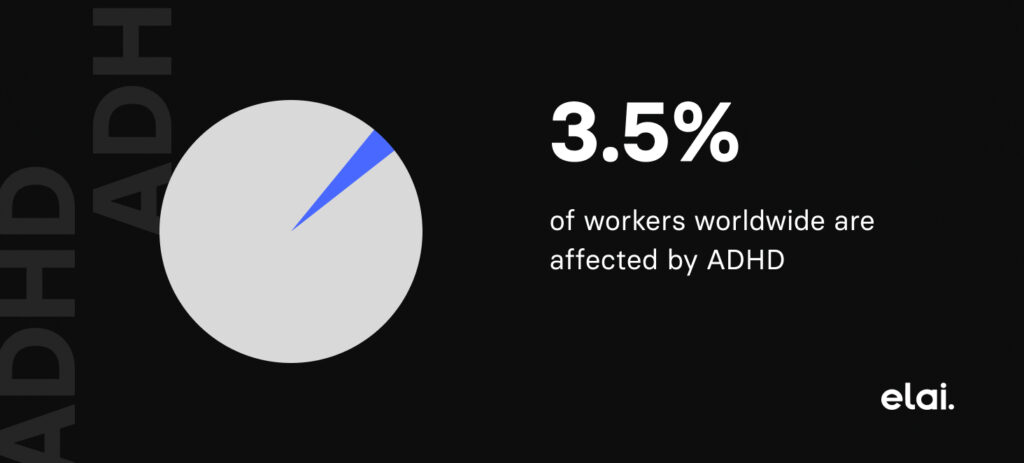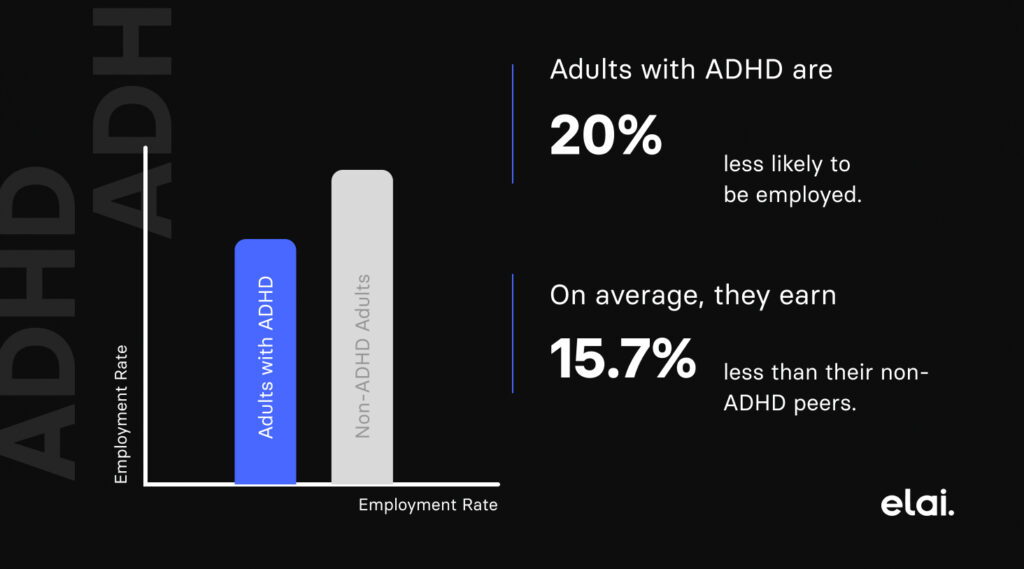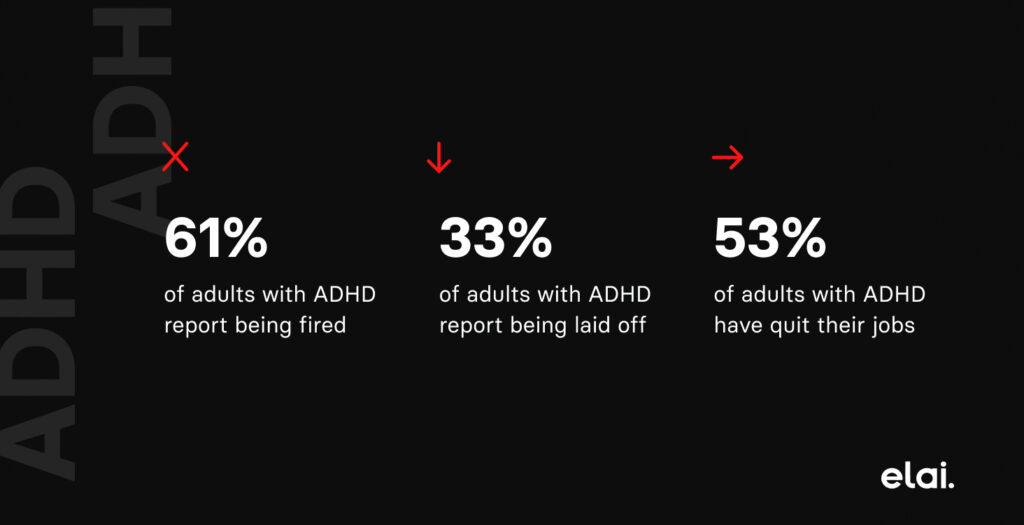ADHD or in other words, Attention Deficit Hyperactivity Disorder is a special condition that can be diagnosed in both adults and children. People with ADGD can face particular challenges, especially in the workplace. Such employees bring their strengths that can be well-regarded only if the company provides a supportive and inclusive working environment. Empowering employees can help to increase overall productivity. In this guide, we will offer insights into what ADHD is, how it affects employees, how to manage an ADHD employee, and practical strategies for creating a workplace that embraces neurodiversity.
What is ADHD?
ADHD is a special condition when people struggle with paying attention, get easily distracted, talk more than others, and act impulsively. Also, individuals with ADHD find it hard to focus, stay organized, and control impulses. These challenges can affect their daily life and interactions with others. Here are some of the common characteristics of employee with ADHD:
Inattention: Frequent distraction from tasks, which can cause deadlines to be missed or lead to other details being overlooked.
Hyperactivity: A compulsive need to remain active and inability to sit still, which sometimes can be viewed as being restless.
Impulsivity: Acting or making quick decisions without thinking about the consequences in a hurry.
ADHD doesn’t determine how intelligent or capable someone is. In fact, It’s important to understand that people with ADHD often bring unique creative solutions and energy to their work. People with such condition are famous for their capability to think outside the box seeking the best possible solution so it is crucial to find the key to managing an ADHD employee to effectively empower their strengths and skills with support when they need it.


Employment Disparities: It is reported that adults with ADHD were 20% less likely to be employed than their non-ADHD adult counterparts and earned 15.7% less.

Job Stability Problems: Adults with ADHD had higher termination rates than their non-ADHD counterparts, at 61% for firing, 33% for layoff, and 53% for quitting.

The strengths of employees with ADHD
Employees with ADHD generally bring a range of strengths to the workplace which are incredibly useful to any organization. They can help on various levels, benefitting the productivity and efficiency of workplace activities.
Creativity
The ability to think outside the box is exactly what most ADHD people possess. They can generate multiple solutions to a single problem by shaping their perspective from a different angle.
Intense focus
Being inattentive and not focusing seems to be one of the biggest challenges of ADHD employees, but when they are extremely interested in something, they can experience a high level of focus that others might not achieve. The intervals of highly productive work when they are in such a mental state are truly mind-blowing. During these periods, individuals tend to have intensive productivity to get a task completed.
Resilience
Naturally, employees with ADHD possess the ability to find creative solutions to problems, however, it’s also worth noting, that ADHD individuals have stronger coping mechanisms because the world wasn’t adapting enough in the past, hence which makes them capable of handling stress in dynamic environments.
High activity and energy levels
Compared to other employees, ADHD ones are generally more naturally energetic, active, and lively. Their enthusiasm and inner motivation are often inspiring for their coworkers, as well as their complete involvement in a task. This can be highly beneficial, especially for companies in which quick thinking is important or which require high mobility and the ability to perform numerous tasks.
Intuition
Their ability to understand the nature of a problem, or even the willingness to try to understand the root of the problem, is natural. They are also generally highly emotionally aware people.
Risk and innovation
Finally, companies that require taking risks and being above an established course can benefit from hiring and managing an employee with ADHD. A lot of successful entrepreneurs of world-leading companies have ADHD and their never-stop attitude brings them further and further continuously.
Challenges faced by employees with ADHD
Although the advantages of ADHD employee in the workplace can be remarkable, they face specific challenges that affect their capability and well-being.
Time management
1. Procrastinating
Situations, where employees with ADHD put off assignments and tasks until the last minute, can cause stress and might happen regularly.
2. Problem estimating the time
At work, it is always difficult for people with ADHD to assess how much time individual projects and tasks will take. At the same time, after planning, the tasks overwhelm them.
3. Prioritization
People with ADHD often focus on less important and at the same time-consuming activities, while more important tasks are being put off.
Organization
1. Difficulty with structuring
Individuals who sometimes struggle to control their work habits may feel overwhelmed with a large amount of documentation that might ultimately lead to disorganized workflows.
2. Forgetfulness
Employees with ADHD might unintentionally make mistakes in performing some tasks related to planning and scheduling due to them forgetting certain details.
3. Paperwork
Similarly, work that requires concentration and careful attention to detail, such as filling out forms or managing complex paperwork, could be challenging and lead to mistakes.
Impulsivity and Focus
1. Sensory Overload
In a flawed corporate environment with constant interruptions where it could be noisy, cold, or hot, employees with ADHD can experience stress and lose their ability to concentrate.
2. Difficulty in building business relationships
Since employees with ADHD are commonly processing information and making decisions in challenging situations faster, as well as expressing themselves quite impulsively, this could be interpreted as disruptive and cause tensions in a team.
3. Emotional regulation
Managing stress, frustration, or anxiety can be more difficult for individuals with ADHD, particularly in high-pressure or demanding work environments.
Empowering Employees with ADHD
To build a truly inclusive workplace for everyone, we must first understand their unique challenges and strengths and find ways how to support an employee with ADHD. Below are some practical steps:
Flexible Work Arrangements
Employees often perform better when they can focus without interruptions. This means that workspaces free from distractions can significantly boost productivity. For instance, remote work arrangements or quiet office spaces can offer employees the focused working environment they need to thrive.
Clear Communication
Instructions and expectations should be kept concise and clear-cut to help keep employees with ADHD on track. Performance should be facilitated with regular check-ins and feedback providing employees with information on their current progress towards the goals of the organization.
Task Management Tools
Discover project management tools, like calendars and to-do lists, as lifesavers when you’re trying to help someone with ADHD stay on top of their work. To keep things organized and on track, setting reminders and alarms can help a lot. It is important to suggest and offer these tools to the employee, but it shouldn’t be mandatory, as these have to be perceived as support, and not the control tools.
Prioritization Assistance
To decrease being overwhelmed with big tasks help employees break them down into smaller, more manageable steps. Simple guidance can be provided by the management to help employees with prioritizing tasks.
Structured Workdays
Employees with ADHD can stay focused on their workload when the routine is consistent. Breaks in the workday can help control energy levels and keep a high level of concentration in employees.
Training and Education
Providing information on ADHD to the managers and their colleagues to help them realize that this type of behavior is not intentional can help build a more supportive working environment. As a result information on the issue being targeted is well known and the stigma attached to either their behavior or ADHD will be reduced.
Strength-Based Approaches
Employees should be allowed to work in areas for which they have the skills and interests.
Special Accommodations
Companies should offer practical support and convenient work arrangements such as noise-canceling headphones to help create a calmer work environment and flexible schedules.
Conclusion
Employees with ADHD often bring creativity, energy, and innovative thinking to the workplace. However, building a productive and supportive working environment requires a particular approach as this group of employees has unique needs. Reasonable accommodations and tailored strategies can help workplaces become more inclusive, productive, and innovative. That would undoubtedly benefit all the employees and the organization overall.

